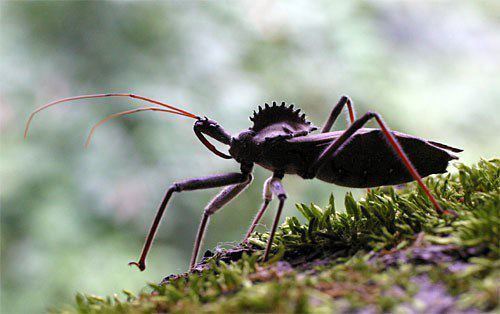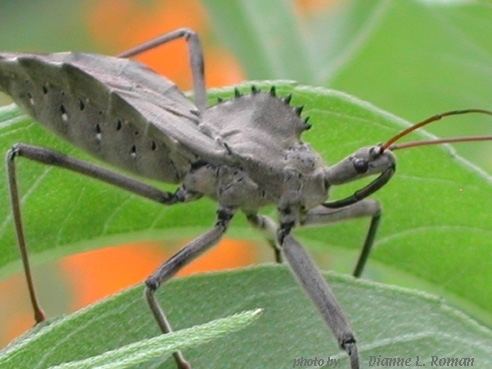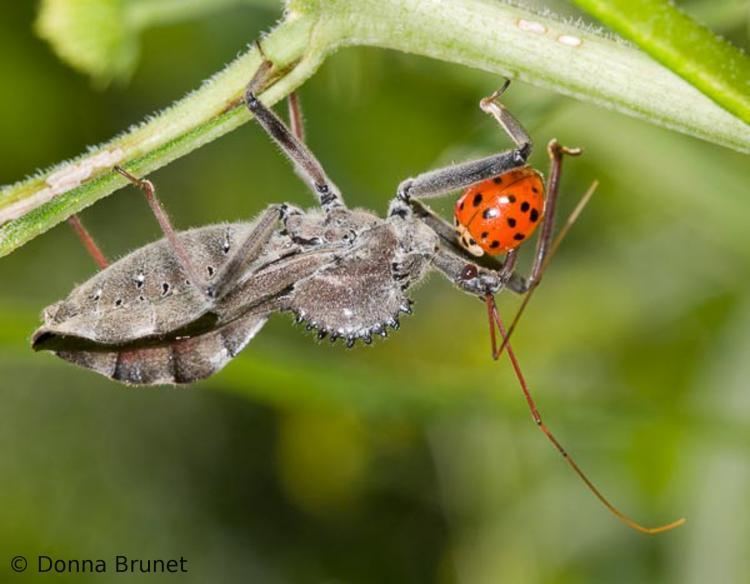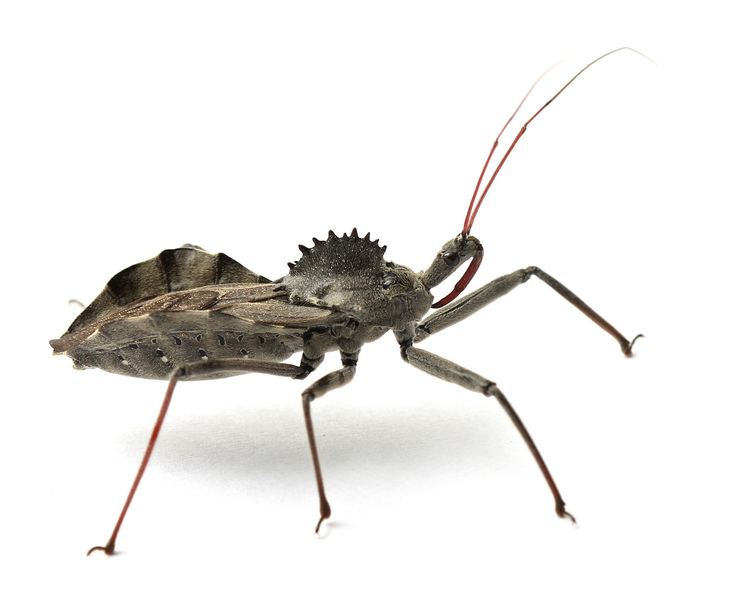Scientific name Arilus cristatus Rank Species | Genus Arilus Order True bugs Higher classification Arilus | |
 | ||
Similar True bugs, Plinthocoelium suaveolens, Plinthocoelium, Aetalionidae, Assassin Bug | ||
Craziest looking wheel bug don t get bit from one of these guys
The wheel bug (Arilus cristatus) is in the family Reduviidae (literally, "hangnail"), which consists of assassin bugs. The species is one of the largest terrestrial true bugs in North America, reaching up to 1.5 inches (38 mm) in length in their adult stage. However, males are smaller in terms of their length and width when compared to females. A characteristic structure is the wheel-shaped pronotal armor. They are predators upon soft-bodied insects such as caterpillars, Japanese beetles, the cabbage worm, orange dogs, tent caterpillars, and the Mexican bean beetle, all of which they pierce with their beak to inject salivary fluids that dissolve soft tissue. Wheel bugs are most active in daylight, though they may engage in predatory behaviors at night in areas illuminated by lights. Because most of their prey are pests, wheel bugs are considered as beneficial to the garden as ladybugs.
Contents
- Craziest looking wheel bug don t get bit from one of these guys
- Wheel bug on the hive
- Characteristics
- Behavior
- Reproduction
- Ecological significance
- Interactions with Humans
- References

Wheel bugs are common in eastern North America, but are confirmed to occupy areas of Mexico and Guatemala in South America. They are camouflaged and very shy, residing in leafy areas and hiding whenever possible. Specifically, habitats of the wheel bug include sunflowers, goldenrod, cotton, trunks of locust trees, and various fruit and tree groves. They have membranous wings, allowing for clumsy, noisy flight which can easily be mistaken for the flight of a large grasshopper. The adult is gray to brownish gray in color and black shortly after molting, but the nymphs (which do not yet have the wheel-shaped structure) have bright red or orange abdomens. It was discovered in 1763 by Carl Linnaeus and taxonified in 1831 by Carl Wilhelm Hahn. Regardless of the prevalence of the wheel bug in many habitats, the information compiled concerning the species is haphazard and incomplete.

Wheel bug on the hive
Characteristics

The wheel bug has a characteristic dorsal crest, shaped like a wheel or cog. It moves and flies slowly, and in flight produces a noisy buzzing sound. As with other assassin bugs, its proboscis arises from the anterior end of its long, tubular head and unfolds forward when feeding.

It possesses two scent glands (red-orange in color) that can be ejected from its abdomen, usually in reaction to being disturbed. The scent produced by it is not as powerful as that produced by the stink bug, but is still strong enough to be detected by humans.

Wheel bugs exhibit armored forewings and membranous hind wings which allow the wheel bug to take flight. As a result of its incapacity to move swiftly, wheel bugs rely heavily upon camouflage, the effect of their punishing, segmented proboscis, or the excretion of unpleasant odors in order to evade predation. In addition, wheel bugs feature cephalization in the form of a pair of long antennae which project from the head.
Behavior
Wheel bugs initiate predation by gripping and pinning their prey with their forelegs. The bug plunges its beak into its victim, pinning its prey with its front legs. It then injects enzymes into the victim, paralyzing it and dissolving its insides, and proceeds to drain the resulting fluids.
The wheel bug is also noted to be very vicious in the wild, and cannibalistic behaviors between them have been noted; for example, nymphs may prey on one another and the female may feed on the male after mating is concluded.
Additionally, the species is capable of disseminating auditory, clicking signals by creating friction between its proboscis and thorax. Though the purpose of this sound is speculated, it may serve as a means of communication between members of the species.
Reproduction
The reproductive cycle of the wheel bug initiates in autumn. When a pair of wheel bugs encounter each other and have coitus, the female will lay 40-200 small, brown, cylindrical eggs, and eventually die. The eggs will hatch in the next spring into eighth millimeter long red nymphs, which will undergo 5 molts until they reach the adult stage the following summer.
Females lay eggs at a low elevation on trees, bushes, twigs, and other objects. Secreted glue serves as an adhesive which maintains the cluster formation of the eggs. After the nymphs hatch, the average length of each molt is roughly 18.8 days, though the 5th and final molt prior to the adult stage is the longest. Eggs generally hatch in the beginning of May and finally mature into adults by July. Overall, it takes roughly 94 days for nymphs to reach maturity. However, the phenology of this life cycle varies based upon the climate which the population occupies. For instance, communities in warm climates may not overwinter as eggs.
In a laboratory test conducted of wheel bugs at the Southern Illinois University Entomology Collection in 1997 and 1998, research revealed that the species’ eggs face the daunting threat of being infected by parasitic organisms, namely Ooencyrtus Johnsoni [1] and Anastatus Reduvii [2]. Of the 12 clusters of eggs monitored in the lab, 10 were ravaged by parasites which prevented the eggs from hatching normally.
The proboscis develops in the early molts, allowing the wheel bug to practice predatory habits in its nymphal stages. Alternatively, the distinctive wheel unique to the species derives only after the wheel bug reaches the adult stage following the final molt.
Ecological significance
Wheel bugs are highly regarded by organic gardeners because they consume a variety of insects and their presence indicates a healthy, pesticide-free ecosystem. "They're the lion or the eagle of your food web," Dr. Michael J. Raupp, an entomologist at the University of Maryland, notes. "They sit on top. When you have these big, ferocious predators in your landscape, that tells me that this is a very healthy landscape, because all these other levels in your food web are intact."
Though wheel bugs are a welcome agent of pest control, they also prey on several ecologically beneficial species. For instance, they incorporate lady beetles and honey bees into their diets. To elaborate, these organisms are widely and highly regarded for their beneficial contributions to ecosystems.
Interactions with Humans
The species is generally indifferent concerning the presence and interruption of humans. Although evidence suggests that wheel bugs can be seemingly be domesticated in controlled environments, if provoked or mishandled, they may attack in an act of defense. As a cautionary warning, the bite of a wheel bug is generally considered to be of greater severity in terms of the level and duration of pain than the sting of common insects like bees. The resulting wound is documented to be extremely painful, lasting, and lingering, accompanied by an unceasing numbness which can persist for days. Furthermore, the vicinity of the injury is known to become heated and irritated. A white crust sometimes forms around the wound during the healing process, though it eventually deteriorates, leaving the small puncture wound visible. Discomfort may last a fortnight or for up to more than half of a calendar year in some cases. However, the latter timeline is frequently attributed to allergic tendencies or the recurrent infection of the original wound.
